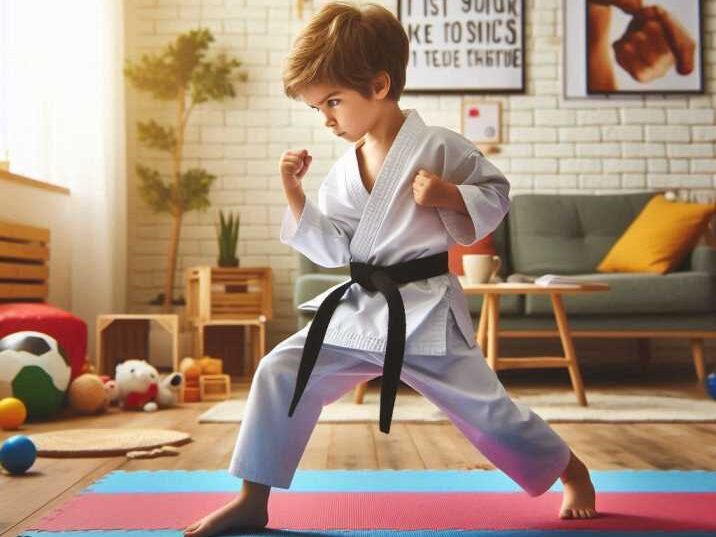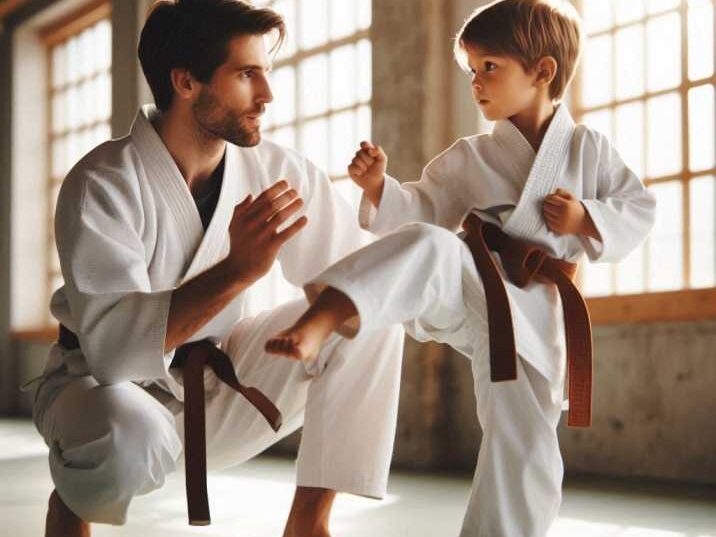Introduction
Table of Contents
Have you ever wondered if your child could learn martial arts at home without needing to join a dojo or studio? With so many online classes, YouTube videos, and self-practice options, it’s a common question parents ask today.
Martial arts are about much more than just kicks and punches. They help kids build confidence, discipline, focus, and fitness. But if your child is shy, busy, or unable to attend classes in person, the idea of self-teaching at home can sound very appealing.
In this guide, we’ll explore whether it’s really possible to teach yourself martial arts at home, what the benefits and risks are, and how parents can keep the journey safe and fun. By the end, you’ll know exactly how to support your child—whether you choose at-home training, professional classes, or a mix of both.

What Does “Teaching Yourself Martial Arts at Home” Mean?
At its simplest, self-teaching martial arts means learning and practicing moves without a live instructor physically guiding you. Instead of joining a dojo or martial arts school, kids (and sometimes adults) use different resources to train at home. This can be fun, flexible, and cost-effective, especially if you’re just starting out. Let’s break down the most common ways kids (with parent support) can learn martial arts at home:
1. Watching Online Tutorials or Training Apps
The internet is full of martial arts content—ranging from YouTube videos to structured online courses and mobile apps designed for beginners. Many instructors now record full lessons that kids can follow step-by-step from the safety of their living room.
- YouTube Tutorials: Free, visual, and easy to follow. Kids can pause, rewind, or watch moves as many times as they like until they get it right. Parents can search for beginner-friendly channels focused on karate, taekwondo, or kickboxing basics.
- Apps and Online Programs: Some apps break lessons into small “levels” or “challenges,” making them fun for kids. These often include tracking systems to measure progress, such as the number of kicks or punches completed.
Why this works: Kids today are already comfortable with screens. Turning screen time into “active learning” is a great way to balance technology with physical activity.
Parent Tip: Make sure to preview the videos first. Choose certified instructors who explain moves slowly and clearly, rather than fast-paced or advanced demonstrations.
2. Practicing Moves from Books or DVDs
Before YouTube, martial arts learners relied on books and instructional DVDs. These resources still have value today because they often include:
- Step-by-step photos showing correct body positions
- Detailed explanations about stance, breathing, and posture
- History and philosophy of martial arts, which helps kids understand the deeper lessons like respect and discipline
Why this works: Books and DVDs encourage kids to slow down and focus on details. Unlike videos, they don’t rush through techniques, which means children can carefully study each step.
Parent Tip: Sit with your child and go through the book together. You can act as their “partner” by holding pads or helping them check their stance. It becomes a shared activity instead of solo learning.
3. Shadowboxing or Kicking Drills at Home
Shadowboxing simply means practicing punches, kicks, and blocks in the air without a partner. It may look simple, but it’s one of the most effective training methods for beginners.
- Shadowboxing Benefits: Builds coordination, balance, speed, and confidence. Kids learn to throw punches or kicks smoothly while imagining an opponent.
- Kicking Drills: Martial arts like taekwondo and karate focus heavily on kicks. At home, kids can practice front kicks, side kicks, or roundhouse kicks against the air, a pad, or even a pillow (under supervision).
Why this works: Shadowboxing teaches kids to control their own body. They don’t need expensive equipment—just space and imagination. Kicking drills, on the other hand, are fantastic for flexibility, strength, and balance.
Parent Tip: Make it fun! Play music while your child practices shadowboxing for 2–3 minutes. Or set “kick challenges” like: “How many clean front kicks can you do in 30 seconds?”
4. Using a Punching Bag, Jump Rope, or Other Simple Equipment
Sometimes the best way to keep kids motivated is with basic training tools.
- Punching Bag: Helps kids develop strength, accuracy, and endurance. Hitting a bag is safer than sparring and lets kids release energy in a controlled way.
- Jump Rope: Many martial artists swear by jump rope training. It improves footwork, coordination, and cardio fitness. Plus, it’s fun and inexpensive.
- Other Tools: Focus pads (held by parents), resistance bands, or agility ladders can all make at-home training more exciting and structured.
Why this works: Kids enjoy variety. Using equipment keeps training fresh and prevents boredom. Plus, tools like punching bags give instant feedback—kids can hear, feel, and see their power improving.
Parent Tip: Always check the equipment is safe and age-appropriate. For example, a heavy adult punching bag may be too much for a young child—lighter bags or foam pads are better for beginners.
The Big Picture
When kids practice martial arts at home—whether through online tutorials, books, shadowboxing, or using equipment—they are building the foundation for future success. It may not replace the full benefits of a dojo or live instructor, but it:
- Sparks interest in martial arts
- Builds basic strength, balance, and coordination
- Gives kids confidence before joining a formal class
In short, self-teaching martial arts at home is possible, especially with parent support. The key is to treat it as a fun introduction, not the final destination.
Benefits of Learning Martial Arts at Home for Kids
Teaching martial arts at home may not give kids the full dojo experience, but it does offer some valuable benefits:
1. Confidence and Independence
When kids practice on their own, they feel proud of what they achieve. Learning how to throw a clean punch or kick gives them a sense of progress. Over time, this independence builds strong self-confidence. It also teaches kids to rely on themselves and trust their own abilities.
2. Flexible Schedule
One of the biggest advantages of at-home martial arts is flexibility. Parents don’t need to rush to classes after work or school. Kids can train whenever it fits into the family’s daily routine—morning, afternoon, or evening. This makes martial arts a stress-free activity rather than another appointment on the calendar.
3. Great for Shy Kids
Not every child feels comfortable in big groups. Some kids are shy or need extra time to warm up socially. At-home training gives them a safe, private space to explore martial arts without pressure. Once they gain confidence at home, they may feel ready to join group classes later on.
4. Physical Fitness
Martial arts are not just about fighting—they’re also about fitness. Even practicing at home helps kids improve strength, balance, flexibility, and endurance. Simple drills like jumping, punching, and kicking get their heart rate up and keep their bodies active. This makes martial arts a fun way to stay healthy without needing a gym.
5. Affordable Start
Martial arts classes can sometimes be expensive, especially when uniforms, gear, and memberships are included. At-home practice gives families an affordable way to start. Free YouTube tutorials, training apps, or inexpensive gear like a jump rope can go a long way. This allows kids to try martial arts before committing to a full program.
Possible Risks or Concerns Parents Should Know
While home training has benefits, parents should also be aware of the challenges:
- Improper Technique – Without guidance, kids may learn moves incorrectly, leading to bad habits.
- Injury Risk – Practicing without supervision can cause strains, falls, or joint injuries.
- Limited Progress – Kids won’t learn sparring, self-defense applications, or belt progression at home.
- Lack of Discipline – Without a teacher, some kids may lose focus or treat practice casually.
Safety Tips for Practicing Martial Arts at Home
Parents can make at-home martial arts safe and rewarding by following these steps:
1. Set Up a Safe Space
Before training, make sure your child has enough room to move freely. Clear the area of furniture, toys, or anything sharp that could cause injury. A soft surface like a mat or carpet helps protect against slips and falls. Having a designated training space also makes practice feel more fun and official for kids.
2. Start with Basics
Kids don’t need to jump into advanced moves right away. Begin with simple punches, kicks, stances, and blocks that are easy to follow. Avoid flips, throws, or complex techniques that could be unsafe without a coach. Mastering the basics builds a strong foundation and keeps practice safe and enjoyable.
3. Supervise Practice
Even if kids seem independent, parent supervision is important. Watching your child ensures they’re using the correct form and not overexerting themselves. You can also remind them to take breaks, stretch, and drink water. This keeps practice structured and helps prevent injuries.
4. Use Online Classes Wisely
Online resources can be great, but not all are kid-friendly. Choose tutorials or apps that are age-appropriate, slow-paced, and easy to understand. Many martial arts schools now offer live Zoom classes, which give kids real-time feedback from instructors while training at home.
5. Combine with Professional Training
At-home practice should be seen as a support system, not a replacement for dojo training. Once your child feels comfortable with the basics, consider enrolling them in a local class. Professional training provides structure, discipline, and sparring experience that can’t be fully replicated at home.
Comparison: Home Training vs. Martial Arts School
| Factor | At-Home Training 🏠 | Martial Arts School 🥋 |
|---|---|---|
| Cost | Free or low-cost | Monthly fees required |
| Flexibility | Anytime, self-paced | Fixed schedule |
| Supervision | Parent-guided | Professional teacher |
| Social Skills | Limited | High (teamwork, friends) |
| Progress & Belts | Hard to measure | Structured ranking |
Conclusion
So, can you teach yourself martial arts at home? Yes, but with limits. Home training is a great way for kids to build confidence, fitness, and interest in martial arts. However, professional classes provide structure, discipline, and safe skill progression that self-teaching can’t replace.
Parents should treat at-home martial arts as a fun starting point—a way to spark passion, keep kids active, and prepare them for formal training later on. With the right guidance and supervision, your child can safely explore martial arts at home and gain valuable life skills along the way.
Positive takeaway: At-home martial arts may not create black belts overnight, but it can create healthy, confident kids ready for any challenge.

FAQs About Teaching Martial Arts at Home
1. Can kids really learn martial arts by themselves?
Kids can learn basic moves and fitness skills at home, but mastering martial arts usually requires a trained instructor.
2. What age can kids start self-teaching martial arts?
Children as young as 5 years old can start with simple drills like stances, punches, and balance exercises.
3. Is it safe for kids to practice kicks and punches at home?
Yes, as long as they have enough space, proper flooring, and parent supervision. Avoid dangerous moves.
4. Which martial arts are easiest to learn at home?
Karate, Taekwondo, and Kickboxing basics are easier for beginners. Grappling arts like Judo or BJJ are harder without partners.
5. Should parents teach martial arts to their kids?
Parents can help by supervising and joining in practice. But for real progress, a qualified instructor is recommended.


